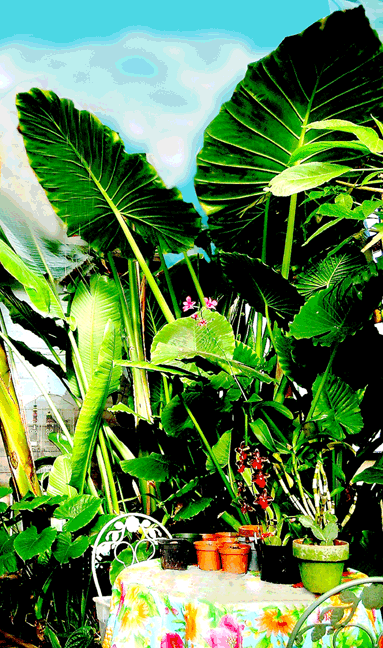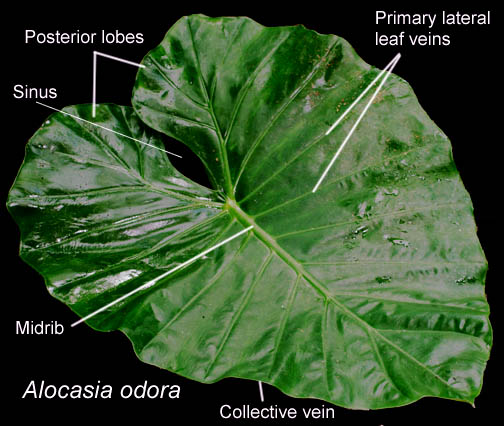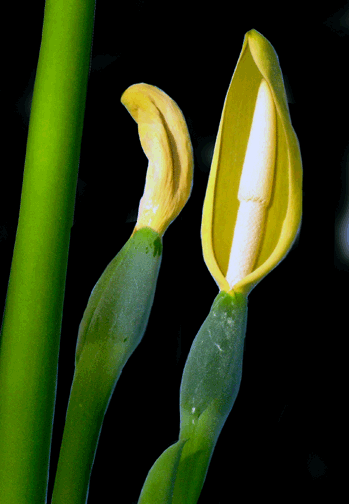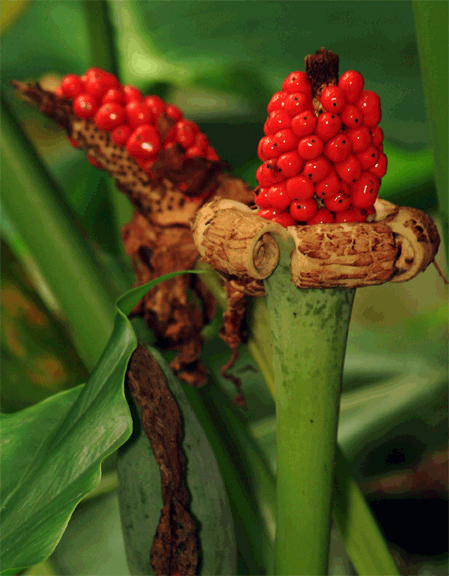![]()
![]()
Aroids and other genera in the Collection
Take the Tour Now?
Orchids
The Exotic Rainforest
Images on this website are copyright protected.
New:
Understanding, pronouncing and using
Botanical terminology, a Glossary
|
Alocasia odora
(Roxb.) K. Koch
Often misidentified as Alocasia macrorrhiza Sometimes incorrectly spelled Alocasia odorata 
Alocasia odora
(Roxb.) K. Koch
A
Giant "Elephant Ear"?
Often
misidentified as
Alocasia macrorrhiza
Incorrectly known as "Alocasia odorata" which is not a species name.
I have a fascination
with plants having large leaves such as this Vietnamese
rain forest giant. The larger the leaf the more I
admire the plant. One of the largest undivided leaf
Alocasia exotics in the tropical plant world (some
would incorrectly call it an "Elephant Ear") is Alocasia
odora from Vietnam
and neighboring islands. The largest is
Alocasia robusta, and I considered growing one!
But A. robusta can easily outgrow our atrium
with leaf shafts that can reach 3.65 meters (12 feet)
and a plant height of 7.5 meters (25 feet)!
Alocasia species are
known to be highly variable and not every leaf of every specimen
will always appear the same. This link explains in greater
detail the scientific principle of natural variation and
morphogenesis.
Click
here.
Although I had always thought Alocasia odora would not survive the winters outdoors in cold climates like Arkansas, it will! My youngest daughter planted three Alocasia odora in her Little Rock yard in the summer of 2006. When it froze during the winter the plants disappeared. But in the spring of 2007 and again in 2008 all three began to grow again! So it does appear to be able to tolerate cold including an occasional freeze! You just have to dig it up and bring it indoors for the winter if you live much further north than Zone 7, minus the leaves of course! We have just provided the Little Rock Zoo with a large quantity of Alocasia odora seeds and hopefully in the coming years you will see it growing all over the park. You can see the spathe and spadix of the species in the inset photo above right and the berries which contain the seeds in the photo left.
All Alocasia sp. are aroids. An aroid is a plant that reproduces via the production of an inflorescence known to science as a spathe and spadix. Most people think the spathe is a "flower" which it is not. The spathe, which in the case of Alocasia odora is pale yellow, is only a modified leaf. If you explore the inflorescence with a magnifying glass when it is ready to be pollinated there are very tiny female, male and sterile male flowers mixed together on the spadix at the center of the spathe which can be found along the spadix. The inflorescence, which is sometimes shaped like a tube, is made of several parts. The portion that appears to be the "flower" is the spathe and inside that is the spadix which somewhat resembles an elongated pine cone. The spadix is a spike on a thickened fleshy axis which can produce tiny flowers. When ready to reproduce the spadix produces the flowers unisexually. The tiny male flowers produce pollen and the tiny female flowers are designed to be receptive to pollen. In the case of Alocasia odora the plant is capable of self pollination when an insect carries pollen from a male flower to a female flower. When the plant is pollinated a red berry will grow with seeds inside. In addition to seeds Alocasia odora reproduces in a second way. In the spring it produces "pups", which grow directly from the base of the parent plant,
These are easy to plant in shallow soil and will grow new giants. In time the plant's stem will lay down and spread along the ground putting up other specimens as it stretches across the surface. Still, it is certainly one of the most impressive plants you can grow. Looking for information about "Elephant Ear" plants?
Aroid Pollination!
Join the International Aroid Society:
http://www.exoticrainforest.com/Join%20IAS.html |
 Alocasia odora reaches
an impressive 3.65 meters (12 feet) in our Exotic
Rainforest atrium and likely larger outdoors. With
stiff leaves that resemble something from a movie about
King Tut or Cleopatra with the leaf blade being used as
a fan, the leaf approaches 4 feet in length.
Alocasia odora is an impressive tropical.
Alocasia odora reaches
an impressive 3.65 meters (12 feet) in our Exotic
Rainforest atrium and likely larger outdoors. With
stiff leaves that resemble something from a movie about
King Tut or Cleopatra with the leaf blade being used as
a fan, the leaf approaches 4 feet in length.
Alocasia odora is an impressive tropical.
 You may find this
plant listed on many websites as "Alocasia odorata". This
is a misspelling and is not recognized as a verified
species name on either TROPICOS (a service of the
Missouri Botanical Garden) or the International Plant
Names Index (IPNI), both of which are botanical source
sites. Alocasia odora does make an impressive
"Elephant Ear" when used as a landscape plant. However,
the term "Elephant Ear" is a poor descriptive term.
That term is sometimes applied to five, perhaps six,
groups of plants (genera) that can include over 3,000
species! Those genera include Alocasia,
Philodendron, Anthurium, Colocasia, Xanthosoma, and
a few Caladium species. So if you ask about an
"Elephant Ear", which species do you mean? All of those
species are quite different and often grow in very
different ways.
You may find this
plant listed on many websites as "Alocasia odorata". This
is a misspelling and is not recognized as a verified
species name on either TROPICOS (a service of the
Missouri Botanical Garden) or the International Plant
Names Index (IPNI), both of which are botanical source
sites. Alocasia odora does make an impressive
"Elephant Ear" when used as a landscape plant. However,
the term "Elephant Ear" is a poor descriptive term.
That term is sometimes applied to five, perhaps six,
groups of plants (genera) that can include over 3,000
species! Those genera include Alocasia,
Philodendron, Anthurium, Colocasia, Xanthosoma, and
a few Caladium species. So if you ask about an
"Elephant Ear", which species do you mean? All of those
species are quite different and often grow in very
different ways. Alocasia odora
has been the source of a great deal of confusion for
collectors. When I originally acquired
the plant in 1998 it was identified by the grower as
Alocasia macrorrhiza. Not until an
expert grower
was kind enough to bring the correct ID to my attention
was I made aware of the error. The key to the correct
ID was the photo of the spathe and my mention of its
size. The spathe of Alocasia macrorrhiza is
substantially larger at 30 to 45cm (12 to 18 inches) and
that plant's elongated spathe actually reflexes and folds backwards
away from the spadix. The leaves of Alocasia
macrorrhiza can easily reach 120 cm (4 feet) in length.
Alocasia odora
has been the source of a great deal of confusion for
collectors. When I originally acquired
the plant in 1998 it was identified by the grower as
Alocasia macrorrhiza. Not until an
expert grower
was kind enough to bring the correct ID to my attention
was I made aware of the error. The key to the correct
ID was the photo of the spathe and my mention of its
size. The spathe of Alocasia macrorrhiza is
substantially larger at 30 to 45cm (12 to 18 inches) and
that plant's elongated spathe actually reflexes and folds backwards
away from the spadix. The leaves of Alocasia
macrorrhiza can easily reach 120 cm (4 feet) in length.